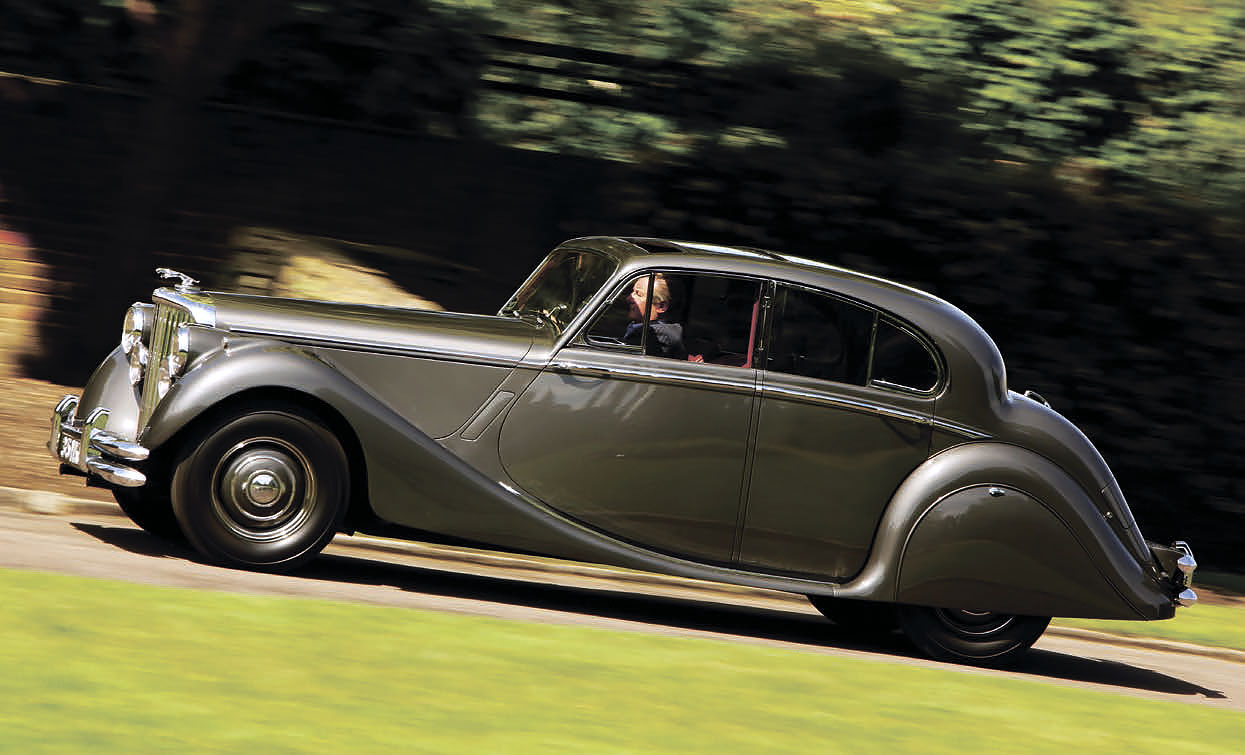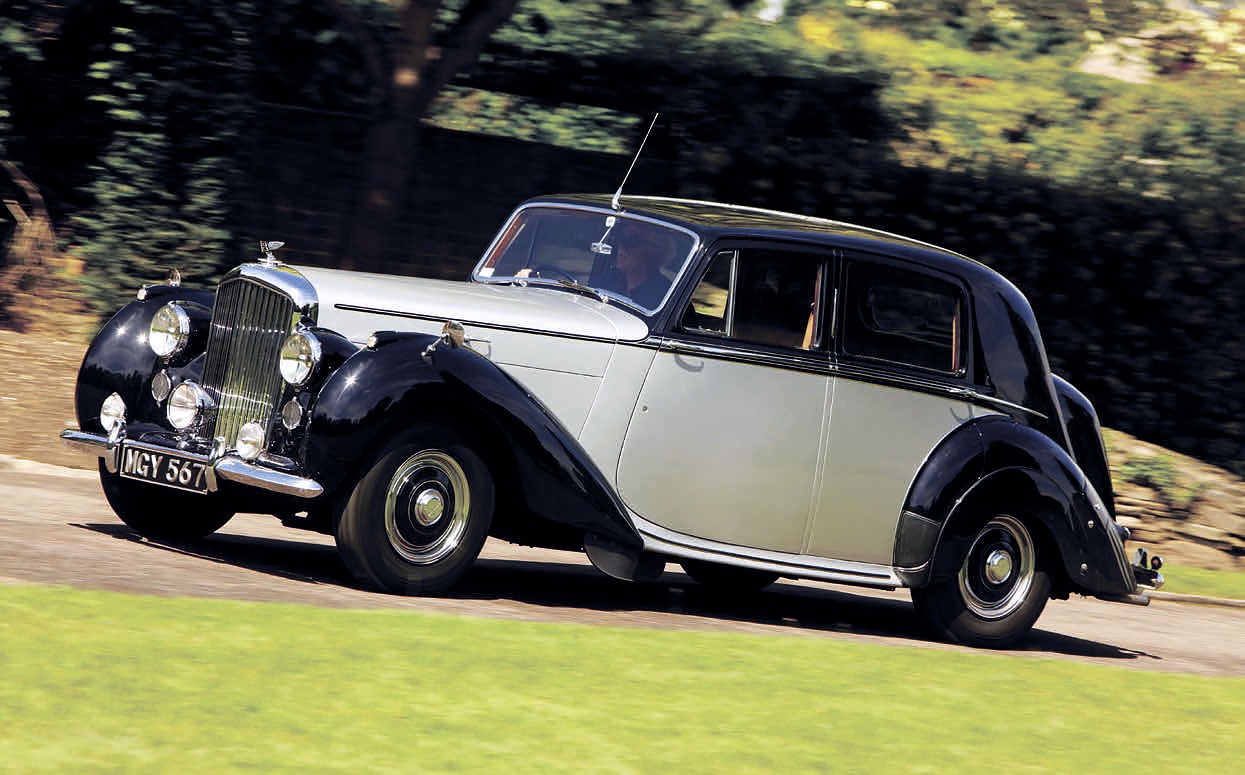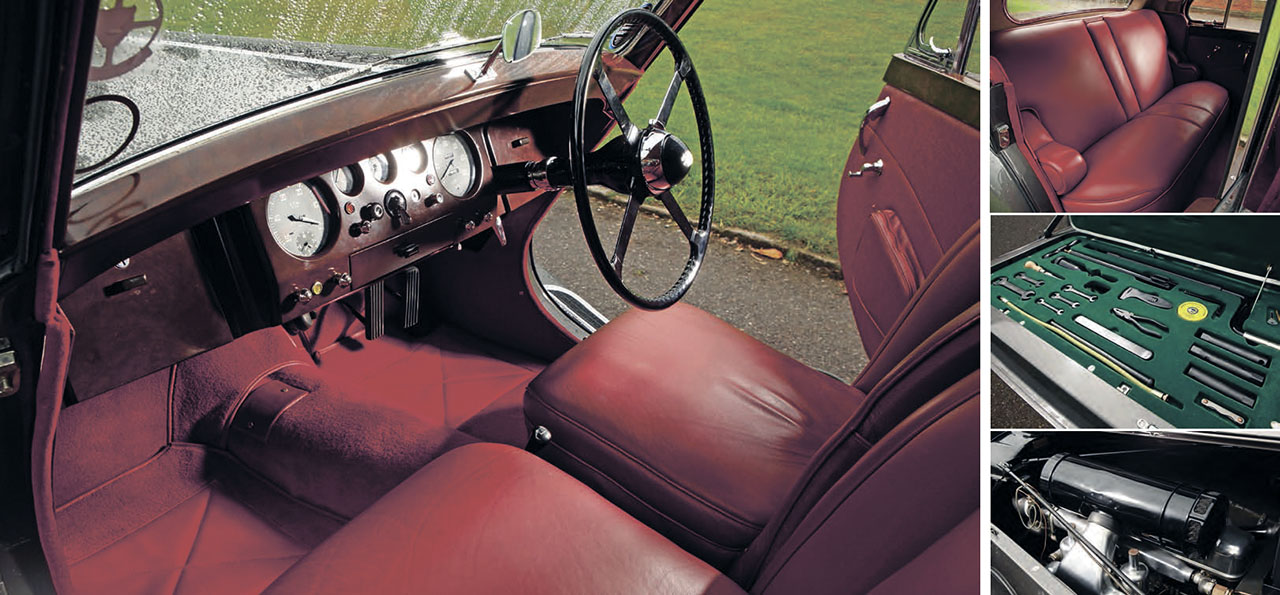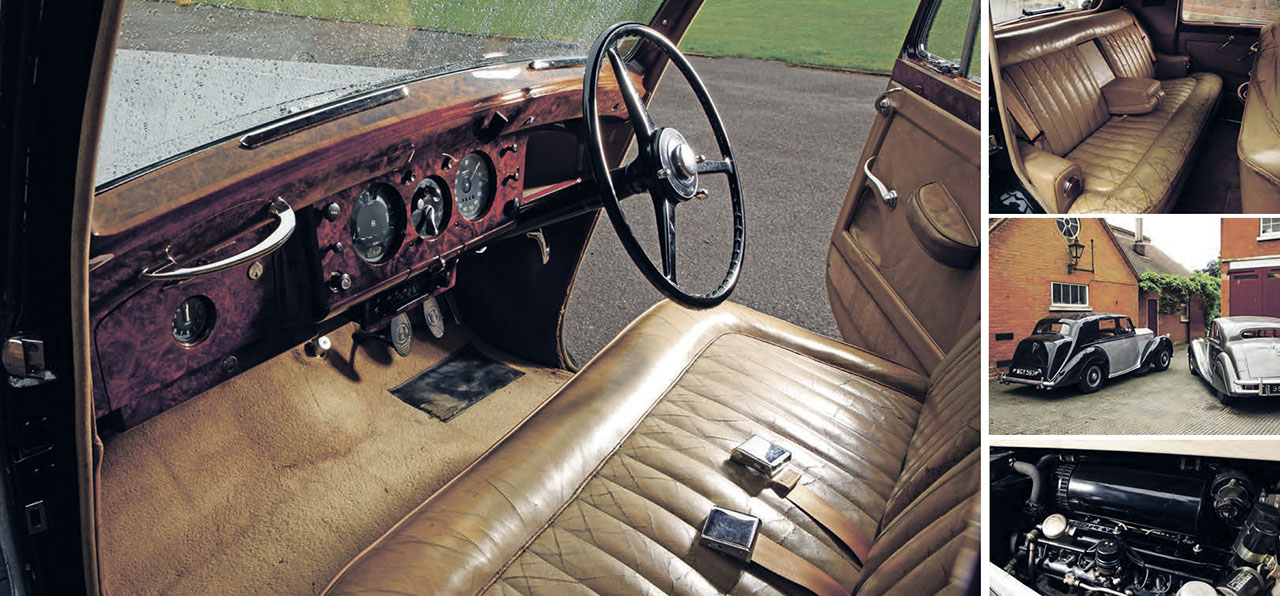
Jaguar’s social climber MkV meets Bentley MkVI. Jaguar vs. Bentley. Caddish MkV takes on the aristocratic, old-money MkVI. Closing the gap. With its rakish MkV saloon, Jaguar gave more expensive cars a run for their money, including Bentley’s suave MkVI, says Jon Pressnell. Photography Tony Baker.
Is it pushing a point to call the MkV the forgotten Jaguar? Perhaps not. The car lasted barely more than two years, the shortest period for any series of Jaguar saloon. Only 10,493 were made, against nearly 26,000 of the preceding SS range and more than 47,000 of the MkVII-IXs that replaced it. And when did you last see one?
The MkV was, of course, both a stopgap model and a transitional one. But it does not deserve to be forgotten, because it was, in my opinion, the single most important Jaguar saloon until the XJ6 came along. Before the MkV, the pre-war Jaguars – the 1½-litre, 2½-litre and 3½-litre – were well-priced and capable cars. But with the arrival of the stylish and beautifully appointed MkV, Jaguar entered another arena: for the first time it was legitimate to compare a Lyons product with considerably more expensive vehicles.

Jag feels unwieldy at first, but you soon adapt to its ways; best suited to open A-roads; steel sunroof was standard on both cars.
Principal amongst these was the MkVI Bentley, and the comparison was made all the easier by the new post-war Crewe model having been judiciously moved down market in response to the changing times. To simplify manufacture and lower costs, it was the first Rolls-Royce product to have a standardised body, made by Pressed Steel. Its new engine was part of a ‘Rationalised Range’ of units with four, six or eight cylinders and a maximum number of shared parts.
Equally important, the Bentley represented an astute response to the social climate prevailing in a grey Britain governed by an ideologically fervent Labour party. Rolls-Royces, with their aristocratic image, were frowned on by socialist politicians, so with the MkVI the firm switched emphasis to the Bentley marque; a Rolls derivative only arrived three years after the Bentley and was intended largely for export. To put the Jaguar in the same basket as a Rolls-Royce would have seemed pretentiously over-ambitious, but with a less upper-crust Bentley the exercise must have seemed more plausible.
This was not least because the MkV marked a quantum leap forward for Jaguar engineering, in that it had an all-new cruciform chassis with torsion-bar independent front suspension inspired by that of the Traction Avant Citroën. Found in shortened form under the XK sports cars, the robust but relatively light frame – complete with hydraulic brakes, for the first time on a Jaguar – was intended to underpin the twincam sports saloon of which William Lyons dreamed. But he realised that production of the XK straight-six would only slowly ramp up, and that it would be better to restrict its use initially to a small run of XK120s. Just as much to the point, it soon became apparent that he would have a long wait before Pressed Steel could provide the new all-enveloping body that he wanted for the ‘100mph saloon’.

Bentley offers deceptive performance and easy drivability; ride generally good, only becoming a tad lively over poor surfaces.
The MkV was a logical way forward. The new chassis – which incorporated telescopic front dampers, an anti-roll bar and an early use of balljoints – could be trialled ahead of its use on the forthcoming MkVII. Power could come from the proven Standard-derived 2½-litre and 3½-litre engines used since 1935, and honourably developing 102bhp and 125bhp. A modernised body could be made in-house at Foleshill, pieced together from small pressings and with limited tooling investment; it could also form a stylistic bridge between the ex-SS pre-war Jaguars and the pontoon-winged MkVII, making this less of a shock when it arrived. All the sums added up.
So it was that the MkV was launched at the 1948 Motor Show, at a price of £1189 for the 2½-litre, and £1263 for the 3½-litre. That wasn’t a huge premium for the bigger engine and, by the time that MkV production ended in June 1951, just 1690 2½-litres had been made, against 8803 3½-litres – including 29 dropheads with the 2664cc ‘six’ and 972 with the 3485cc version. These figures might seem modest, but they helped Jaguar to register its highest output to date in 1950, of 7206 cars, most of them MkVs.
If the Jaguar represented evolution, the Bentley was more of a culture shock. Over six model years, the pre-war ‘Derby’ Bentleys clocked up a run of 2411 cars, a sizeable slice of the combined output of Royces and Bentleys during this period. But the company was making too many unrelated models, with abysmal profitability and – surprising though it may sound – uneven reliability. Additionally, the sourcing of all bodywork from outside coachbuilders delighted lovers of the bespoke, but the quality was often poor.
‘TO PUT THE JAGUAR IN THE SAME BASKET AS A BENTLEY MUST HAVE SEEMED PLAUSIBLE’
A sense of crisis came to pervade the upper reaches of management: the cars, it was felt, did not deserve their exalted reputation. Accordingly, a plan was put in place for shared chassis and engine design across the range as a way of driving down costs and pushing up quality. This led to the MkV Bentley, intended for an autumn 1939 announcement but cancelled at the advent of war when just 11 had been made. It had a new cruciform chassis and Packard-inspired coilsprung independent front suspension that used the arms of the lever-type dampers to form the upper wishbones. The overhead-valve engine was carried over from its predecessors but was intended to be replaced for 1941 by an inletover- exhaust straight-six from the new range of power units then being developed.
The MkVI, announced in May 1946, picked up on the MkV’s part-riveted chassis, shared with the R-R Silver Wraith, but added the IoE engine and hydraulic front brakes, and clothed the result in that Pressed Steel body. The shell represented a sizeable investment – one that would only be amortised after 5000 cars – but meant that the cost of each body would be half that of a coachbuilt Park Ward saloon. Rolls-Royce was now locked into a higher production rate than it had been accustomed to, but with a potentially more profitable car that could hopefully be made to better quality, all while keeping its price premium. At £4038 in 1950, the Bentley still cost more than three times the 3½-litre Jaguar, pretty much as had been the case before the war.
Beginning life with a 4257cc engine delivering 132bhp on twin SU carbs, the MkVI received a bored-out 4566cc unit in 1951. With a freerflowing dual exhaust – the previous single-pipe system had absorbed a massive 28bhp – output rose to 153bhp and torque improved significantly. In September 1952 the MkVI was given a bigger boot with a lift-up lid, and was redesignated the R-type. In this format it continued until April 1955, with a fully welded chassis from late 1953, to eliminate weaknesses encountered with the part-riveted frame. The Bentley was a more select machine than the Jaguar, with just 7521 MkVIs and R-types made (Continentals excluded), plus 761 of the derived (but lowerpowered) R-R Silver Dawn launched in 1949. All the same, these were transformational figures for Rolls-Royce. By 1951, the tooling costs of the body were well on the way to being written off.
Contemplate Neville Hamilton’s MkV and you can’t help thinking that the Jaguar has acquired all the aesthetic virtues displayed by the best Derby Bentleys of pre-war years. Notwithstanding its slightly bulbous rear, there is a lithe, racy elegance to the Jaguar, emphasised by its sweeping wingline. It looks longer and lower than the ‘Big Bore’ MkVI of Angus Thornes, the 3½ in lower height disguising that it is 5in shorter than the 16ft Bentley. The chromed door superstructure further adds to the lighter and more airy feel of the Coventry car, although the beefy double-blade bumpers have the opposite effect. In comparison the MkVI seems more upright, but also more conservative. That’s partly down to its more razor-edged lines, and to the absence of the Jaguar’s running boards.
‘THERE IS A LITHE, RACY ELEGANCE TO THE JAG, EMPHASISED BY THE SWEEPING WINGLINE’
The MkV’s interior radiates quiet good taste, with unpleated leather upholstery and lustrous wood veneer. Sculpted, height-adjustable bucket seats give good support to those in front, while in the spacious rear there are delightful settee-like curved side armrests and a central one that assumes an odd angle when down. It’s finely executed, but there isn’t a lot of it: the notoriously penny-wise William Lyons clearly had no intention of ratcheting up manufacturing costs by adding needless items of equipment.
In contrast, the Bentley cossets its occupants with a wood-veneer lady’s companion to one side of the rear quarters and a matching smoker’s tidy to the other, plus lift-out footrests and a big cantilever-hinged picnic tray. The front armrests are adjustable, there is a quick-release window mechanism for the driver, a slider-controlled rear-window blind and the usual Crewe circular switch panel with its chrome controls. The seats are pleated hide, which makes them look less classy than those of the Jaguar, but the woodwork features inlays that evoke coachbuilding practice.
Turning to the driving, in the Jaguar you sit close to a big, black, four-spoke wheel and have a stubby gearlever on the transmission tunnel – it’s stiff in action and with a long throw for first and second, and a tighter gate for third to fourth. Mated to a smooth, long-travel clutch that takes up quite late, it’s a shift that demands a firm hand, but is a crisp pleasure to manipulate. These Moss gearboxes are supposed to be difficult, but I never clashed a gear, confirming my impression that this reputation is unmerited.

Clockwise: Jag’s wheel has just indicator controls on boss; toolkit in bootlid; low floor in roomy rear, thanks to split prop (as on MkVI). Clockwise: recessed lamp for rear cabin; engine is Standard-based but was built by Jaguar; clock inside rev counter; novel zipped front door pocket.
The Weslake-head ex-Standard engine is impressively smooth, offering ample seamless power and turning over at a lazy 3500rpm when approaching 70mph. At 80mph it is still pulling strongly, if more vocally, and is about 10mph inside its genuine maximum, with wind noise the main impediment to its otherwise unflustered progress. As was then customary, the MkV is a touch low-geared, so you can pull away in second and creep along in top, should you wish.
The Burman recirculating-ball steering is relatively slow and matched to a generous turning circle, so you don’t want to leave a turn too late. It is reasonably communicative once on the move, and the car – initially unwieldy – shrinks around you. On twisting roads, the Jaguar corners with poise. Bad surfaces reveal a slight softness to the front end, as well as a bit of structural movement, while the retention of crossplies means that it tends to follow irregularities. The brakes, meanwhile, have a long pedal action but work adequately. All in all, the MkV comes across as highly competent, but more of an open-road car than one for rural lanes.
‘THE MkV DOESN’T HAVE THE PRECISION FEEL OF THE CREWE CAR, BUT IT IS TRULY EXCELLENT’
In the Bentley you immediately feel at ease, with a higher, more commanding driving position that makes the car feel narrower than is really the case: it’s half an inch wider than the Jaguar. The key to unlocking the pleasures of the Bentley is the right-hand gearlever. Nestling in a cut-out to the seat, it requires a different arm action and grip from a more accessible central shift, plus it has a tight gate that eliminates any waggling around to find the cogs. A positive movement back and forward is needed, and you are rewarded with a taut, well-oiled mechanical action, albeit with a fairly long travel between first and second. Decently synchronised, this is a honey of a gearchange, and from it derives much of the pleasure of driving the Bentley.

Clockwise: controls for mixture, dampers, throttle on wheel of Bentley, which has more formal lines; side bolsters on ‘Big Bore’ cars. Clockwise: combined four instrument gauge on left, but no rev counter; toolkit in tray under clock; silky-smooth IoE ‘six’; massive single picnic tray in back.
For an engine a litre larger than that of the Jaguar, the surprise is that for a saloon still advertised as ‘The Silent Sports Car’ the power unit is in fact more obtrusive. You know you have a large-displacement multi-cylinder engine under your right foot. It’s not coarse – heavens no! – but there is a subdued bass tone of which you are always aware. Yet when you accelerate, the IoE ‘six’ never loses its composure. Thanks to low gearing and a solid wall of torque, the Bentley is even more effortless than the MkV, happily starting in second, pulling through roundabouts in third and being able to be trickled along in top. Drivability is uncanny. You can let out the clutch on the smallest of throttle openings, and the car won’t stall – so smooth is the power takeup. With the ‘Big Bore’ Bentleys being just about 100mph cars, 60-70mph cruising is disdainfully relaxed, with the engine unruffled and wind noise the main disturbance. Just don’t expect better than 14-16mpg, advises Thornes.
The Bentley’s Marles cam-and-roller steering is on the heavy and low-geared side at parking speeds, but feels well-weighted, smooth and more alert when on the move – and with no lost motion. It’s pretty spot-on, really. With the front end checked by an anti-roll bar, it doesn’t lean excessively when cornered, either. The MkVI feels secure enough on the radials fitted to this car, and it rides comfortably enough for a vehicle with a leaf-sprung rear. The hydro-mechanical brakes – assisted by the traditional Rolls-Royce gearbox-driven servo – are soft for check braking; but stand on the pedal and they are staunchly effective, even if the Bentley’s nose dips significantly under sharp braking. Set-up is critical, and I would prefer them to take up sooner.
Put bluntly, the MkVI screams quality. The engineering is exquisite, the car needs little acclimatisation and is totally usable, whether on narrow country roads or the dual-carriageway. The Jaguar demands that you adapt to its way of going about business, but feels smoother if less sparkling. It doesn’t have the precision feel of the Crewe car, but it is a truly excellent piece of kit: civilised, well appointed, and very classy. In contrast, the Bentley is conservative – dull, even. But it has an underlying quality that is supremely seductive, and it delights from behind the wheel.
If I’d been in the market for such a car, I’d have purchased the Bentley, if I could have afforded it. But few had the wealth to do so. For those of still quite substantial means who aspired to a top-rank big saloon, you could buy the Jaguar for a third of the price, and hold your head high. Never mind the slightly blousy MkVII, the ‘forgotten Jaguar’ is the one that you should remember. The MkV is a superb achievement. It’s no Bentley, but there’s far less clear blue water between the two cars than you’d imagine.
Thanks to Bentley Drivers Club: bdcl.org; Tim Millbank: prideandjoyclassiccars.com; Allan Crouch, JDC: jaguardriver.co.uk; Capel Manor: capelmanorgardens.co.uk





